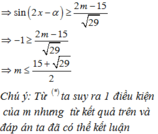Tìm m để Bất phương trình 4 sin 2 x + cos 2 x + 17 sin 2 x + 3 cos 2 x + m + 1 ≥ 2 luôn đúng?
![]()
![]()
![]()
![]()
Hãy nhập câu hỏi của bạn vào đây, nếu là tài khoản VIP, bạn sẽ được ưu tiên trả lời.


![]()



Lý thuyết đồ thị:
Phương trình \(f\left(x\right)=m\) có nghiệm khi và chỉ khi \(f\left(x\right)_{min}\le m\le f\left(x\right)_{max}\)
Hoặc sử dụng điều kiện có nghiệm của pt lương giác bậc nhất (tùy bạn)
a.
\(\dfrac{\sqrt{3}}{2}\left(1-cos2x\right)+\dfrac{1}{2}sin2x=m\)
\(\Leftrightarrow\dfrac{1}{2}sin2x-\dfrac{\sqrt{3}}{2}cos2x+\dfrac{\sqrt{3}}{2}=m\)
\(\Leftrightarrow sin\left(2x-\dfrac{\pi}{3}\right)+\dfrac{\sqrt{3}}{2}=m\)
\(\Rightarrow\) Pt có nghiệm khi và chỉ khi:
\(-1+\dfrac{\sqrt{3}}{2}\le m\le1+\dfrac{\sqrt{3}}{2}\)
b.
\(\Leftrightarrow\dfrac{3}{2}\left(1-cos2x\right)-sin2x+m=0\)
\(\Leftrightarrow sin2x+\dfrac{3}{2}cos2x-\dfrac{3}{2}=m\)
\(\Leftrightarrow\dfrac{\sqrt{13}}{2}\left(\dfrac{2}{\sqrt{13}}sin2x+\dfrac{3}{\sqrt{13}}cos2x\right)-\dfrac{3}{2}=m\)
Đặt \(\dfrac{2}{\sqrt{13}}=cosa\) với \(a\in\left(0;\dfrac{\pi}{2}\right)\)
\(\Rightarrow\dfrac{\sqrt{13}}{2}sin\left(2x+a\right)-\dfrac{3}{2}=m\)
Phương trình có nghiệm khi và chỉ khi:
\(\dfrac{-\sqrt{13}-3}{2}\le m\le\dfrac{\sqrt{13}-3}{2}\)

a) \(\sqrt{3}\left(\dfrac{1+cos2x}{2}\right)+\dfrac{1}{2}sin2x=m\) ↔ \(\dfrac{\sqrt{3}}{2}cos2x+\dfrac{1}{2}sin2x=m-\dfrac{\sqrt{3}}{2}\)
→\(\sqrt{3}cos2x+sin2x=2m-\sqrt{3}\) ↔ \(2cos\left(\dfrac{\pi}{6}-2x\right)=2m-\sqrt{3}\)
→\(cos\left(\dfrac{\pi}{6}-2x\right)=m-\dfrac{\sqrt{3}}{2}\)
Pt có nghiệm khi và chỉ khi \(-1\le m-\dfrac{\sqrt{3}}{2}\le1\)
b) \(\left(3+m\right)sin^2x-2sinx.cosx+mcos^2x=0\)
cosx=0→ sinx=0=> vô lý
→ sinx#0 chia cả 2 vế của pt cho cos2x ta đc:
\(\left(3+m\right)tan^2x-2tanx+m=0\)
pt có nghiệm ⇔ △' ≥0
Tự giải phần sau
c) \(\left(1-m\right)sin^2x+2\left(m-1\right)sinx.cosx-\left(2m+1\right)cos^2x=0\)
⇔cosx=0→sinx=0→ vô lý
⇒ cosx#0 chia cả 2 vế pt cho cos2x
\(\left(1-m\right)tan^2x+2\left(m-1\right)tanx-\left(2m+1\right)=0\)
pt có nghiệm khi và chỉ khi △' ≥ 0
Tự giải

Với \(cosx=0\) ko phải nghiệm
Với \(cosx\ne0\) chia 2 vế cho \(cos^2x\)
\(\Rightarrow tan^2x-4\sqrt{3}tanx+1=-2\left(1+tan^2x\right)\)
\(\Leftrightarrow3tan^2x-4\sqrt{3}tanx+3=0\)
\(\Rightarrow\left[{}\begin{matrix}tanx=\sqrt{3}\\tanx=\dfrac{\sqrt{3}}{3}\end{matrix}\right.\)
\(\Rightarrow\left[{}\begin{matrix}x=\dfrac{\pi}{3}+k\pi\\x=\dfrac{\pi}{6}+k\pi\end{matrix}\right.\)

\(sin^2x-2m.sinx.cosx-sinx.cosx+2mcos^2x=0\)
\(\Leftrightarrow sinx\left(sinx-cosx\right)-2mcosx\left(sinx-cosx\right)=0\)
\(\Leftrightarrow\left(sinx-cosx\right)\left(sinx-2m.cosx\right)=0\)
\(\Rightarrow\left[{}\begin{matrix}sinx=cosx\\sinx=2m.cosx\end{matrix}\right.\)
\(\Rightarrow\left[{}\begin{matrix}tanx=1\\tanx=2m\end{matrix}\right.\)
Do \(tanx=1\) ko có nghiệm đã cho nên \(tanx=2m\) phải có nghiệm trên khoảng đã cho
\(\Rightarrow tan\left(\dfrac{\pi}{4}\right)< 2m< tan\left(\dfrac{\pi}{3}\right)\)
\(\Rightarrow1< 2m< \sqrt[]{3}\)
\(\Rightarrow m\in\left(\dfrac{1}{2};\dfrac{\sqrt{3}}{2}\right)\) (hoặc có thể 1 đáp án là tập con của tập này cũng được)

\(\Leftrightarrow cosx+2sinx+3=2m.cosx-m.sinx+4m\)
\(\Leftrightarrow\left(m+2\right)sinx+\left(1-2m\right)cosx=4m-3\)
Pt đã cho có nghiệm khi và chỉ khi:
\(\left(m+2\right)^2+\left(1-2m\right)^2\ge\left(4m-3\right)^2\)
\(\Leftrightarrow11m^2-24m+4\le0\)
\(\Rightarrow\frac{2}{11}\le m\le2\)

c.
\(\Leftrightarrow cos\left(x+12^0\right)+cos\left(90^0-78^0+x\right)=1\)
\(\Leftrightarrow2cos\left(x+12^0\right)=1\)
\(\Leftrightarrow cos\left(x+12^0\right)=\dfrac{1}{2}\)
\(\Leftrightarrow\left[{}\begin{matrix}x+12^0=60^0+k360^0\\x+12^0=-60^0+k360^0\end{matrix}\right.\)
\(\Rightarrow\left[{}\begin{matrix}x=48^0+k360^0\\x=-72^0+k360^0\end{matrix}\right.\)
2.
Do \(-1\le sin\left(3x-27^0\right)\le1\) nên pt có nghiệm khi:
\(\left\{{}\begin{matrix}2m^2+m\ge-1\\2m^2+m\le1\end{matrix}\right.\) \(\Leftrightarrow\left\{{}\begin{matrix}2m^2+m+1\ge0\left(luôn-đúng\right)\\2m^2+m-1\le0\end{matrix}\right.\)
\(\Rightarrow-1\le m\le\dfrac{1}{2}\)
a.
\(\Rightarrow\left[{}\begin{matrix}x+15^0=arccos\left(\dfrac{2}{5}\right)+k360^0\\x+15^0=-arccos\left(\dfrac{2}{5}\right)+k360^0\end{matrix}\right.\)
\(\Rightarrow\left[{}\begin{matrix}x=-15^0+arccos\left(\dfrac{2}{5}\right)+k360^0\\x=-15^0-arccos\left(\dfrac{2}{5}\right)+k360^0\end{matrix}\right.\)
b.
\(2x-10^0=arccot\left(4\right)+k180^0\)
\(\Rightarrow x=5^0+\dfrac{1}{2}arccot\left(4\right)+k90^0\)